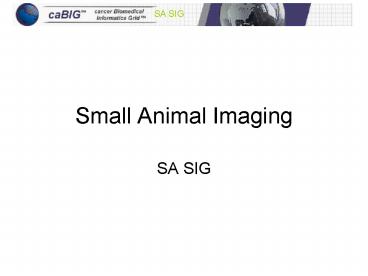Small Animal Imaging - PowerPoint PPT Presentation
1 / 30
Title:
Small Animal Imaging
Description:
Small Animal Imaging – PowerPoint PPT presentation
Number of Views:225
Avg rating:3.0/5.0
Title: Small Animal Imaging
1
Small Animal Imaging
- SA SIG
2
FAC
- Most humans are all animal
- Not all animals are human
- You have a head on your shoulders
3
Quick History
- Long long ago Beginnings of Human Imaging.
- Late 70s digital imaging tomography.
- Human based on the scientific concept of the
crown.
Archimedes
4
State-of-the-Art
- Human Imaging
- VS
- non-human animal imaging.
- THUS
- Reverse Translation of Human Imaging to Animal
Imaging Technology Required.
5
Visualization and Quantification of Fat
6
Models Prostate Cancer
7
Imaging Radiology to Histology
8
Imaging MRI Histology
9
Novel Contrast Agents
10
Contrast Agents In-Vivo, In-Vitro
NIST NINDS GUMC
11
Concept of Integrated Imaging
12
Pre-Post Intervention Link
Adapted from Dr. T. J. FitzGerald, Quality
Assurance Review Center Directors Thursday
Presentation.
- Free text is perhaps not the best annotation for
preclinical research data. Classification may be
needed. VOCABULARY
13
Stereotaxic Surgery
14
Stereotaxic Imaging
15
Histological Sectioning
16
Todays Products
17
Some Industry SAI Leaders
18
SOME Collaborating Institutions
You Too can become a part of this!
19
Objectives
- Establish overall structure and scope for Small
Animal Imaging projects. - Prioritize Small Animal imaging projects for
Workspace. - Define requirements for Small Animal Imaging data
management standards. - Propose integration requirements for caBIG
Compliant In Vivo Imaging data management
software and tools. - Define operational requirements and procedures
for caBIG integration of relevant small animal
medical imaging commercial software systems.
- Prioritize tool and software development
requirements. - Create specifications against prioritized tools
and activities. - Develop test and validation requirement standards
for Workspace software and tools. - Review completed tools and projects, and evaluate
against initial specification, test and
validation requirements.
20
Establish overall structure and scope for Small
Animal Imaging projects.
- Call to Industry and SAILs centers
- Import/export of image data, meta file data.
- Link to associated data, spectroscopy, histology,
etc. (to be defined.) - Visualization tools (veterinary radiology
space.), mapping of multimodality data. - Identifier/classification labeling.
- Annotation CAD.
21
Prioritize Small Animal imaging projects for
Workspace.
- Call to Industry.
- Call to major small animal imaging centers.
- Use of survey material
22
Define requirements for Small Animal Imaging data
management standards.
- Read/import image data from all digital imaging
sources (DICOM may not be correctly implemented
on these systems.) - Read/import metafile information (not always part
of header, sometimes separate file or not
available.) - Link radiological image data to histological
image data and potentially. - Map animal data to relevant human disease
(Jackson Lab).
23
Define requirements for Small Animal Imaging data
management standards. (Continued)
- White paper on SAI data sources/formats.
- Identifier/classification labeling
(modality(ies), species, type of animal model
(genetic, induced, xenograft, mode of induction) - Link data to genetic/other data.
- Veterinary coordinate system
24
Propose integration requirements for caBIG
Compliant In Vivo Imaging data management
software and tools.
- Linear Methodology.
- Call to Standards and Interoperability (SIO).
- Call to Software
- Suggest standards to industry and SAILs perhaps
through NCI, NCRR and other relevant funding
agencies.
25
Define operational requirements and procedures
for caBIG integration of relevant small animal
medical imaging commercial software systems.
26
Prioritize tool and software development
requirements.
27
Create specifications against prioritized tools
and activities.
28
Develop test and validation requirement standards
for Workspace software and tools.
- Call to test bed what are you doing (remember
emulation is the highest form of flattery) I.e.
evaluate tumor volume with model (growth) and
treatment (smaller??). - Co-register modalities, phantom work.
29
Review completed tools and projects, and evaluate
against initial specification, test and
validation requirements.
30
Summary
- Vocabulary Species, Models, contrast
agents/tracers/ligans, Coordinates (rostral),
Identifiers.































